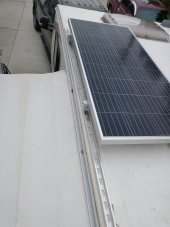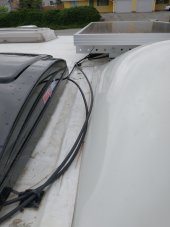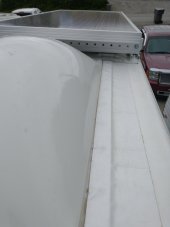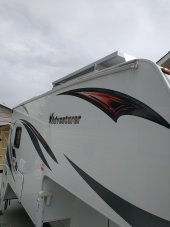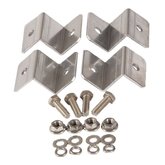memilanuk
New Member
- Joined
- Apr 21, 2021
- Messages
- 125
We did a pretty hefty electrical system upgrade to our slide-in truck camper (2017 Adventurer 910DB) back in November/December. Up top, I used half-height aluminum strut channel either screwed directly into the aluminum roof frame where possible, or using well nuts (for the two holes where it wasn't). I installed some Eco-Worthy tilting brackets across the rails to hold the four 215 watt panels. The brackets are quite a bit wider (28") than the panels (~25") and the underlying rails (I forget what the exact spacing is - maybe 20"?) so they are sort of cantilevered over the inner rail by 4-5".
The goal wasn't so much being able to tilt the panels for increase solar 'harvest' as it was being able to get under the dang panels for roof maintenance, etc. without having to unbolt everything. Seemed like a good idea when I ordered, but in actual practice... the brackets sat a *lot* higher than I'd anticipated. Given that I'm not planning on getting under the panels all that often, I'm re-thinking whether I should replace those brackets with something that rides lower. I was considering getting some more low-profile / half-height strut channel and bolting the panels to that, and then attaching the upper/cross channel to the lower channel... but I'm a little concerned about being able to get my hands under there (especially on one of the panels, there is very little room between the edge of the panel and the center roof fan) to reach those spots where the panel cantilevers over the inside rail. A full-height strut channel would still be about half the height of those dang brackets, so there is that...
Thoughts? Suggestions?
The goal wasn't so much being able to tilt the panels for increase solar 'harvest' as it was being able to get under the dang panels for roof maintenance, etc. without having to unbolt everything. Seemed like a good idea when I ordered, but in actual practice... the brackets sat a *lot* higher than I'd anticipated. Given that I'm not planning on getting under the panels all that often, I'm re-thinking whether I should replace those brackets with something that rides lower. I was considering getting some more low-profile / half-height strut channel and bolting the panels to that, and then attaching the upper/cross channel to the lower channel... but I'm a little concerned about being able to get my hands under there (especially on one of the panels, there is very little room between the edge of the panel and the center roof fan) to reach those spots where the panel cantilevers over the inside rail. A full-height strut channel would still be about half the height of those dang brackets, so there is that...
Thoughts? Suggestions?




